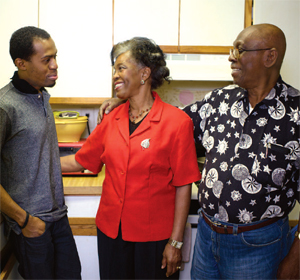Brain Surgery: Marie's Story
Treating Marie’s Giant Aneurysm with Tiny Coils
For years, Marie lived with what she called, “a big, big, big headache.” She says, “I tried ice packs and different medications, but nothing worked well.” Sometimes the pain stopped. Often it didn’t and was accompanied by blurry vision and a watery right eye.
Diagnostic Expertise
In September 2012, a particularly severe headache forced Marie to cut short a visit to her native country of Haiti and return to Silver Spring. The headaches were getting worse and two months later, Marie woke up with unbearable pain. Her grandson rushed her to Holy Cross Hospital.
CT scans swiftly ruled out the possibility of brain tumors or cancer. What was revealed: an aneurysm three decades in the making that now could be classified as a giant aneurysm due to its size—30 millimeters, or over an inch, in diameter.
“I was really surprised when the doctor told me that,” Marie says.
Despite the many years this undiagnosed aneurysm had existed in Marie’s brain, time was running out. “Without immediate treatment,” says James Jaffe, MD, Interventional Neuroradiologist, “Marie faced blindness in her right eye and the possibility of a fatal rupture.”

Sixty-six-year-old Marie Jeanty enjoys spending time with her grandson, Ewald, and her husband, Walter, in their Silver Spring home.
Minimally Invasive Brain Procedures
At Holy Cross Hospital, neurologists, neurosurgeons, neuroradiologists and specially trained nurses work together to plan the best possible, least invasive treatment for each patient.
Because Marie’s giant aneurysm was too dangerous for standard open surgery, Dr. Jaffe considered endovascular coiling. With coiling, tiny detachable platinum coils are snaked through a patient’s blood vessels up into the aneurysm, where they are packed into the cavity to prevent blood from entering it. If an aneurysm is abnormally large, coils also are used in the artery beneath it.
To see if Marie would be a good candidate for coiling, Dr. Jaffe evaluated how well the arteries in the surrounding areas would be able to pick up the extra blood flow. “Marie passed the test,” he says.
Coiling is one of many advanced procedures for aneurysms and related conditions. “New innovations including softer coils, more advanced stents and liquid polymers to block off malformed blood vessels are regularly entering the treatment equation,” Dr. Jaffe explains. “And Holy Cross Hospital is one of the few area hospitals to offer them.”
Neuro Critical Care Unit
After five hours of surgery, Marie spent three days recovering in Holy Cross Hospital’s Neuro Critical Care Unit, where a team of experts monitored her around the clock. Marie’s neuroscience care team included Dr. Jaffe; Zachary Levine, MD, medical director of neurosurgery at Holy Cross Health; as well as specially trained nurses, nurse practitioners and physician assistants, some who talked with Marie in her primary language of French.
“Holy Cross is a good hospital,” she says.
A Life Restored
Today, Marie’s severe headaches are gone, and her vision is getting better. She goes back to Holy Cross Hospital every few months for checkups and CT scans; however, she no longer needs to take medicine, and she’s been able to resume the activities she enjoys—watching football, cooking and spending time with her family.
